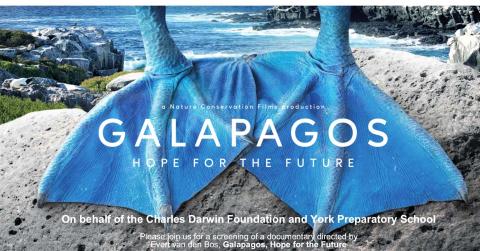Galapagos’ Charles Darwin Foundation: An International Good Practice that Needs to be Supported

A couple of weeks ago, I had the honor of being invited by the Charles Darwin Foundation (CDF) to the screening of a new documentary directed by Evert van den Bos, Galapagos, Hope for the Future. It was held in New York City as part of a meeting of the Foundation’s Board of Directors, which offered me the opportunity to meet some of the members and learn more about its work.
In watching the documentary, I was greatly struck once again by the sheer beauty of these desolate islands and their unique animals and plants. The documentary also presents with great clarity how, on a daily basis, teams of the Foundation and its Research Station, working alongside teams of the Galapagos National Park Service, conduct vital scientific research and complementary action to ensure the conservation of the environment and biodiversity in the Galapagos Archipelago.
The Archipelago, located in the Pacific Ocean off the coast of Ecuador, is a UNESCO World Natural Heritage Site. Figuratively speaking, the Galapagos were “put on the map” and became a magnet of international curiosity and scientific interest, with the publication in 1858 of Charles Darwin’s groundbreaking work of evolutionary biology, On the Origin of the Species. Indeed, Darwin’s visit to some of the islands in the Archipelago during his expedition on the HMS Beagle in 1835 helped him collect evidence of evolution in the diversity of the Galapagos species that led to his observation that species descending from a common ancestor evolve over many generations through a process of natural selection (the process whereby organisms better adapted to their environment tend to survive and produce more offspring).
In 1959, the Government of Ecuador designated all parts of the islands that were not inhabited by humans as a National Park (96% of the total archipelago’s surface area). The same year, the Charles Darwin Foundation was created, and in 1964, the Charles Darwin Research Station opened to conduct scientific studies aimed at protecting indigenous plant and animal life. In 1968, the Galapagos National Park Service, a governmental institution, was established to protect the Archipelago.
Institutions, such as foundations, can play a major role in a society. Over the past 60 years, the CDF, operating with limited resources, has become a beacon of international good practice, offering valuable lessons for the rest of the world. The vision statement of the CDF clearly illustrates how this type of role can be operationalized for the common good: “to contribute to a sustainable Galapagos by providing breakthrough research which informs conservation actions and inspires humanity to conserve this extraordinary Archipelago and our planet as a whole.”
As shown in the documentary and described in the CDF’s most recent Annual Report, the range and value of the work conducted and supported by the Foundation are outstanding. With a small team of staff and volunteers (about 217 people), the Foundation oversees and supports work by scholars and thesis students, both Ecuadorean and from other countries; visiting scientists developing their own projects with a research permit issued by the Galapagos National Park; and collaborating scientists who carry out projects linked to CDF projects.
The research includes marine projects as varied as the study of the status of the Galapagos penguin, flightless cormorant, and albatross populations; research on marine invasive species for the prevention, detection, and management of the Galapagos Marine Reserve (GMR); exploring and surveying seamounts and other deep water environments between depths of 40 to 3200 meters in the GMR ; and studies to reduce the threat of vessel impact for the green turtle in the Islands.
Terrestrial ecosystem research projects include research on ecological restoration and sustainable agriculture; analysis of satellite images and drone image processing to map the expansion of invasive plant species; restoration of scalesia forests, which have a very high biodiversity of associated plants, birds, and invertebrates, compared to other ecosystems in the Galapagos; and assessment of the health status of giant tortoise across a human-modified environment. The latter study is looking in depth at the impact on the giant tortoise population of the cohabitation between tortoises, domestic animals, and humans in the islands that are inhabited by humans in terms of the spread of diseases and antimicrobial resistance that can pose a risk for the conservation of this unique species.
The CDF’s work also includes critical communication, outreach, and extension work, such as the Sharks Ambassadors education initiative program for high school-aged students, that focuses on shark conservation. In terms of knowledge management, the CDF is custodian of four Natural History Collections—Herbarium (CDS), Terrestrial Invertebrates (ICCDRS); Marine Invertebrates (MCCDRS); and Vertebrates (VCCDRS)—which constitute the largest collections of endemic, native, and exotic species of the Galapagos in the world. The library of the CDF is the main bibliographic repository of the Scientific Station and also manages the archival materials. Additionally, resources from the CDF fund conservation activities, such as the mangrove finch project, aimed to conserve this species and prevent its disappearance (there are currently only around 100 individuals left in the world).
The operation and work of the CDF relies 100 percent on private support from individuals, institutions, and corporations. Therefore, for all of us interested in preserving the unique ecosystem of the Galapagos Archipelago as our legacy to future generations, a priority challenge is financial resource mobilization to ensure predictable and sustainable funding for the CDF.
How can this be done in the short- and medium-terms?
An expansion and diversification of the CDF’s funding sources is perhaps required, involving both earmarked Ecuadorian Government contributions and private donations, for the implementation of a results-oriented medium-term strategy and action plan for the CDF.
First, in Ecuador, as in other countries, there is the potential to mobilize more in taxes as a share of GDP via better tax administration (including value-added taxes), tackling tax avoidance and evasion, broadening the tax base by removing cost-ineffective tax expenditures, and increasing excise taxes on unhealthy products (including on tobacco, alcohol, and sugar-sweetened drinks), and where feasible, some of which can flow to expand fiscal space for conservation work under the CDF and the Galapagos National Park.
Second, the national effort could be complemented with the establishment of dedicated trust funds with grant resources mobilized from ecological conservation and climate action-oriented governments in high-income countries. The allocation of trust fund resources could be linked to the achievement of pre-defined activities and results, such as the development of a monitoring program to assess the threat posed by marine plastic debris as potential transport for introducing non-native species that could become invasive and harmful to the ecosystem in the Islands.
Third, with the support of the Government of Ecuador, grant resources for global public goods available under existing mechanisms in multilateral finance institutions such as the World Bank Group and the Inter-American Development Bank, could be explored and invite technical proposals from the CDF for consideration by these organizations.
Fourth, diversification of private funding will be crucial. Different foundations and philanthropies could be tapped to support the CDF as some of them are already committed to support the achievement of the Sustainable Development Goals (SDGs) of the United Nations by 2030, and the work of the CDF is focused on supporting the achievement of several SDGs’ economic, environmental, and social targets. Entities such as the Bloomberg Philanthropies, The Bill and Melinda Gates Foundation, The Nippon Foundation, The Rockefeller Foundation, and The Carlos Slim Foundation, are only a small sample of possible additional sources for diversifying CDF funding. Donations from wealthy individuals, both in Ecuador and at the international level, and the general public could help to mobilize financial support as well.
Fifth, in pursuing active resource mobilization options, raising the profile of the CDF and educating different stakeholders about the results and impact of its conservation work will be required. Events organized by institutions such as the Salzburg Global Seminar and the World Economic Forum, as well as the Annual Meetings of the World Bank Group/International Monetary Fund, could serve as potential venues for information, communication, and education efforts geared to mobilize commitments and support from different international stakeholders.
Naturally, any increase in funding levels would need to be accompanied by strong administrative and financial arrangements at the CDF, complemented by robust monitoring, evaluation, and reporting mechanisms on resource use, activities undertaken, results, and impact achieved.
Looking forward
The preservation of World Natural Heritages sites, such as the Galapagos Archipelago, depends on the active and dedicated mobilization of support from a broad group of committed stakeholders, both in Ecuador and across the world. If done efficiently and effectively, this effort would help to ensure that the benefits of this global public good will not be limited to the current generations but will also be for the enjoyment of future generations as our lasting legacy to them. In doing so, we will be contributing to preserve the unique “natural history” of these islands, where, as observed by Charles Darwin in The Voyage of the Beagle:
“Most of the organic productions are aboriginal creations, found nowhere else; there is even a difference between the inhabitants of the different islands; yet all show a marked relationship with those of America, though separated from the continent by an open space of ocean, between 500 and 600 miles in width. The archipelago is a little world within itself, or rather a satellite attached to America, whence it has derived a few stray colonists, and has received the general character of its indigenous productions. Considering the small size of the islands, we feel the more astonished at the number of their aboriginal beings, and at their confined range. Seeing every height crowned with its crater, and the boundaries of most of the lava-streams still distinct, we are led to believe that within a period geologically recent the unbroken ocean was here spread out. Hence, both in space and time, we seem to be brought somewhat near to the great fact—the mystery of mysteries—the first appearances of new beings on this earth.”
Contact information:
Charles Darwin Foundation for the Galapagos Islands
Puerto Ayora, Santa Cruz, Galapagos, Ecuador
T: +593 (5) 2526 146
PP Box 17-1-3891 Quito, Ecuador
To make a donation:
The work of the CDF scientists is only possible through your donations. Your gift supports research, conservation and outreach efforts. Help us achieve our goal of preserving the wonder that is the Galapagos Islands for future generations. Choose your way to donate below:
Charles Darwin Foundation - Donate
Tax-deductible donations for U.S. donors can also be made via wire transfer to the Friends of the Charles Darwin Foundation for the Galapagos Islands bank account in the U.S. If selecting this option, please contact us at fundraising@fcdarwin.org.ec.
Account Friends of the Charles Darwin Foundation for the Galapagos Islands
Address 420 Columbus Avenue, Suite 304, Valhalla, NY 10595-1382, United States
Bank Citibank
Routing Number021-000-089
Account Number6780613592
SWIFTCITIUS33
Address Thornwood, NY, United States
Donations from other countries can also be received directly at the Charles Darwin Foundation’s bank account with Kleinwort Hambros Bank Ltd. in London, United Kingdom. If selecting this option, please contact us at fundraising@fcdarwin.org.ec.
Account Charles Darwin Foundation
Address 54 Avenue Louise, 1150 Brussels, Belgium
Bank Kleinwort Hambros Bank Ltd.
Account Number49234501
IBANGB26 HAMB 4048 5849 2345 01
SWIFTHAMBGB2L
Bank Address8 St. James’s Square, SW1Y 4JU London, U.K.
For donations from Ecuador inferior to $5,000 you can also make a direct transfer to our bank account with the Banco del Pacífico. If you select this option, please contact us at fundraising@fcdarwin.org.ec.
Account Charles Darwin Foundation
Bank Banco del Pacífico
Current Account 1664468
SWIFTPACIECEG 871
Address Avenida Charles Darwin, Galápagos, Ecuador
Reference Donación para la Fundación Charles Darwin
RUC1790985105001

